
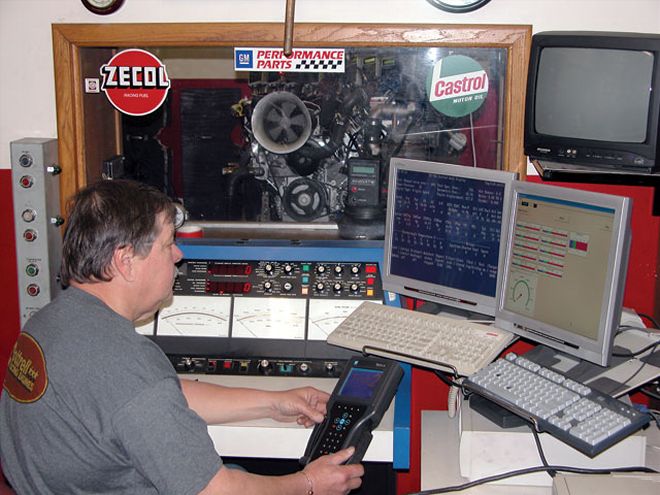
Given a choice between spending $500 for a day on the dyno and upgrading to a trick set of cylinder heads, most hot rodders on a budget would opt for the hardware. But a different view should be considered.
"A good set of heads on a poorly tuned engine is simply a poor set of heads," argues Harold Bettes of SuperFlow. "The goal should be to maximize the stack of parts you have."
Engine dyno testing is most often viewed as a necessity for race teams and possibly a luxury for wealthy street-car owners. Yet the benefits for any modified street/strip engine, especially today's EFI motors, are easily justified for most homegrown projects. A dyno test can be as simple as a half-day routine to properly break in the engine, check for leaks or unusual noises, and set the timing and jetting for the intended gasoline, or it can run into several days of trying different parts and tune-ups. "You may see a swing of 40 or more horsepower simply from good tuning," Bettes says.
The more adventurous may try different camshafts, carbs, and headers. Regardless of the test agenda, any problems discovered will be easier to correct on a dyno stand than under the hood. In the long run, it's also cheaper to test 'n' tune an engine on the dyno than at the track.
Larry Meaux of Meaux Racing Heads remembers a Super Stock engine builder who was relatively successful without dyno testing, but when he couldn't find any more improvements and suffered through a long dry spell, he pulled the engine for a day at Meaux's shop.
"I picked up a solid 10th and 2 mph because I could go after 4 or 5 hp at a time," Meaux says. "Eventually, at the end of the day, we found 25 total horsepower, but there's no way he could verify a 4hp change with a run down the track. The car simply isn't repeatable to see 4 or 5 hp."
Another argument for dyno runs before track testing comes from Allan Bessant of BEP Performance. He'll ask an undecided customer to add up costs in fuel, tires, feeding a crew, towing, and track fees. "After a full day testing at the track, he still may not have found the right formula," Bessant says. "On the dyno, I can tune the engine, get the right converter, and help him find his shift points."
More shops are installing engine dynos, allowing customers a choice in many regions. But a dyno cell remains a huge investment-ranging from $35,000 to well over $100,000-so customer prices start at $250 for a half-day and can climb up to $1,500 for a full day, depending on the engine and test routine. The average full-day price for a carbureted Chevy V-8 is about $500 to $700. Some shops charge more for non-Chevys due to the extra time and parts needed for hookup. Engines with EFI or forced induction require a dyno operator with higher skills, so the appointment may also be more expensive.
Despite the proven benefits of dyno testing an engine, misconceptions still tend to drive the decision process for many potential customers. Ron Quarnstrom of R&R Performance claims he has dyno'd 6,000 engines in the past 18 years, including a 13.2hp Perkins diesel for lawn mowers and a 165hp chain saw motor. He's built fixtures for just about every internal combustion engine within 500 miles of his Minnesota shop, and his biggest assignment is coming this summer: a 30-cylinder Chrysler A57 multibank engine from a '43 Sherman tank. The A57 is basically five, six-cylinder inline engines sharing a common crankcase. Problem is, the engine won't fit through the doors leading into the R&R dyno cell. Quarnstrom is likely to position the engine outside the door and feed the absorber with a long driveshaft. Not only has Quarnstrom seen a variety of engines, he's worked with all types of owners and their egos.
"I tell them it's not the motor's fault, it's doing what it should," Quarnstrom says. "It's just that the predictions and expectations were set too high."
High optimism can be traced to glowing magazine articles, exaggerated advertising claims, or six-pack-induced bench racing. Also, too many shops race their dynos or use their dynos just to sell horsepower.
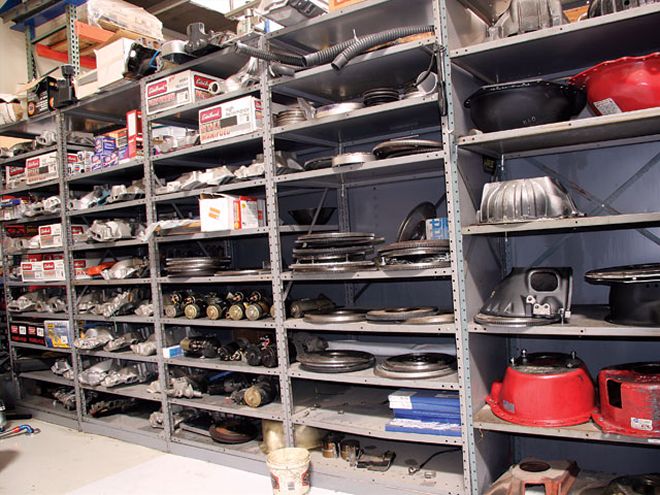 Most dyno shops are equipped with bellhousings and flywheels to accommodate popular engines, but customers should meet with the dyno operator to create a checklist of parts to bring to the session.
Most dyno shops are equipped with bellhousings and flywheels to accommodate popular engines, but customers should meet with the dyno operator to create a checklist of parts to bring to the session.
Hooking up with a reputable dyno operator is clearly the first objective when planning a dyno test. Ask friends or talk to racers at the track. When a shop is selected, don't be afraid to question the dyno operator about the equipment and how often it's calibrated or tested. If the dyno cell is messy and greasy, there probably isn't much regular maintenance done to the dyno itself. A cluttered workbench may be a sign of poor organization and takes up time between pulls. An accurate dyno cell has excellent ventilation, plenty of clean air, and proper routing for the exhaust.
Preparation and planning are the keys to a successful day on the dyno. Work closely with the operator to set a realistic schedule and determine who brings what to the party. Items most often in question are the water pump, distributor, ignition box, starter, bellhousing, flywheel or flexplate, and fuel. The customer's engine should be as close to finished as possible. Some shops prefer to use the customer's fuel regulator to match the conditions in the vehicle. If you use different fuels for street/strip action, bring a few gallons of both. "They don't all use the same air/fuel ratio," Bettes warns.
Headers and exhaust should also be discussed. Dyno headers have provisions for the exhaust gas temperature (EGT) sensors, but the shop may not have a set that is close to the customer's size and length. One common solution is custom header plates that support the EGT sensors and accept customer headers. Another is to run a full day's test with the dyno headers then install the customer's tubes to measure any difference. EFI, dry-sump, and turbo/supercharged engines require additional consultation to set goals, plan the day's schedule, and ensure the right equipment is available.
A basic test session will narrow down ignition timing, carb jetting, and valve lash in addition to checking for leaks and potential trouble spots. Changing carbs may be beneficial if the dyno operator senses the carburetor is incorrectly sized. He may also suggest a carb spacer. Changing cams is considerably more time consuming, but an exposed beltdrive or two-piece timing cover will speed up the swap.
"Be sure all the cams work," Bessant cautions. "I've seen the customer install a second cam for the first time and discover piston-to-valve clearance problems. Mock up all the cams before you go the dyno. And it helps if you know how to degree a cam properly."
"I've seen experienced circle-track racers change cams in 45 minutes," says Quarnstrom, who has also tested as many as four V-8 engines in one day.
Testing procedures vary between dyno operators. Some prefer a step test, where the engine rpm is held steady while the data is recorded. Most prefer acceleration tests, where the computer runs the engine through the rpm range and collects data at various speeds. The most popular is 300 rpm per second, but some circle-track customers go slower, and high-powered drag racers go higher. Customers should familiarize themselves with the different tests and types of data the dyno acquisition software will record. Each dyno run can generate 8 to 10 pages of data.
"The greatest single waste of time on dyno day is trying to analyze all the data on site," Bettes says. "Have a plan, and keep good notes relative to the changes you made. Take carbs, throw jets at it, take jets away, see what the net is in general terms, and move to the next test.
"If you tune by looking at spark plugs and numbers, you'll leave power on the table," he adds. "On the dyno, you tune for best overall power curve then look at the plugs and say, 'That's the look I need to duplicate at the racetrack.'"
It's unlikely a dyno test will hurt a properly built engine. Most shops have dyno mules that log hundreds of pulls before breaking or needing to be rebuilt. Modern dynos are designed to complete the tests quickly and have safety systems to warn of low oil pressure and other dangers.
Some dyno operators are now using high-tech data-acquisition equipment and simulation software to speed up the testing or gather precise information for more advanced research. Meaux has his own programs to predict on-track performance and analyze airflow, both in the cylinder head and exhaust, and can use this data to help dial in areas on the car that may be hurting the overall performance. Working with the exhaust software, Meaux will reduce or extend header collectors to find 2 or 3 more horsepower. He also looks for unwanted reversion in the numbers.
"We can see reversion or a positive wave coming from the overlap in the air turbine specs," Meaux says. "First we try to find a sweet spot with the headers, make a few pulls, and play with the cam if we have to."
Meaux also adapts O2 sensors to individual header pipes and not just the collector to determine fuel distribution. This test is particularly useful when tuning Quadrajets, ThermoQuads, or other carburetors with large secondaries.
"The velocity profile coming out of the bottom of the carb is drastically different from front to back and so is the fuel distribution," Meaux explains. "I've seen up to 27hp gain playing with epoxy and air dams in the intake [to correct the distribution]. You can tell a bunch of stuff from the dyno. It's a tool. It's a just a matter of how you use it."
Case Study
An engine tested by Westech Performance offers a solid argument for dyno runs on a basic street engine. The subject was a single four-barrel, 355ci Chevy, assembled by a "professional" engine builder at a cost of $5,500. The builder claimed he broke-in the engine (it has a hydraulic roller camshaft) on a test stand and promised 420 hp. The following is a rundown of the dyno test:
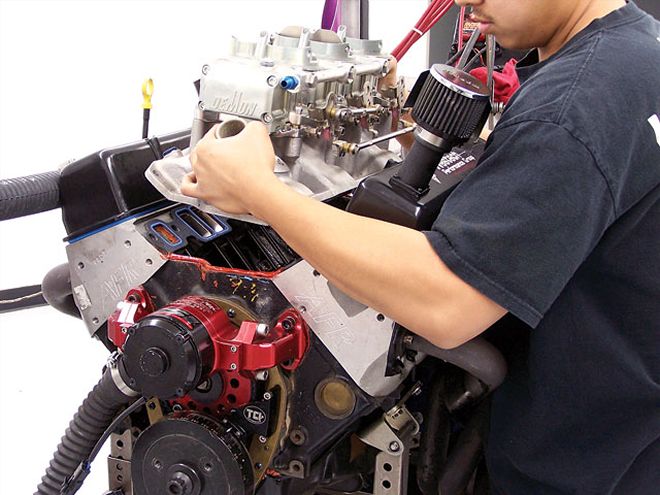 Plan ahead if equipment changes are to be made. Be sure to have all necessary fasteners, gaskets, and specialty tools.
Plan ahead if equipment changes are to be made. Be sure to have all necessary fasteners, gaskets, and specialty tools.
Turbocharged Engines
"Compared to a normally aspirated engine, turbos are really a pain to dyno."
That comment comes from the turbo maestro himself, Kenny Duttweiler, but he also says dyno testing turbocharged engines, especially if they have EFI, is imperative. Testing strictly at the track can be frustrating.
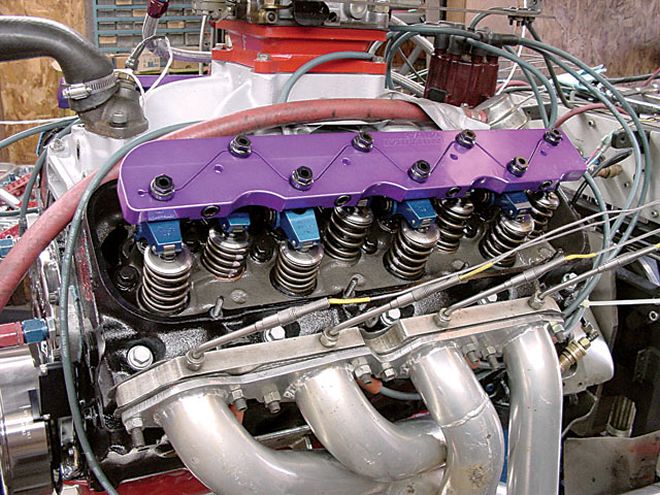 Meaux has developed header plates to keep the EGT sensors in the exact position for every test. These plates also allow testing of the customers' headers without drilling holes for the sensors.
Meaux has developed header plates to keep the EGT sensors in the exact position for every test. These plates also allow testing of the customers' headers without drilling holes for the sensors.
"Turbochargers are load-sensitive, so they're going to work better when they're under a controlled load at the dyno," Duttweiler says. "Somewhere in this equation, you have to develop a fuel map, and it has to be generated at various load sites."
Duttweiler says a strong dyno that can hold power at low rpm levels is necessary to his strategy of fuel mapping. "A lot of dynos won't hold turbo engines below 6,000 rpm," says Duttweiler, who relies on a Heinen-Freud absorber and AVL data acquisition. "I can hold 1,000 lb-ft at 1,000 rpm."
Working with a full rpm range is important to establish proper fuel and spark calibration throughout the engine's needs, including the launch. "If you have a Powerglide and set the transbrake at 5,000 rpm, you need to test the ability of the engine to pull itself up to that point," Duttweiler explains. "And shifting a Powerglide can bring you from, as an example, 8,800 rpm down to about 4,000 rpm. You need to fill in all the dots between those points."
Those dots are cells in the fuel-mapping calibrations, and Duttweiler looks at every one. "A load site for fuel mapping might have 200 cells to fill in," Duttweiler says. "Not that it'll ever visit all 200, but each cell-which may be 500 rpm wide by 2 pounds of boost tall-will influence the cells around [it]."
Duttweiler also uses a computer-controlled throttle valve and writes programs for specific tests. He can simulate runs down the track or develop break-in procedures to suit each engine.
"My way of thinking: A dyno is a necessity," he says.
Engine-Owner Checklist
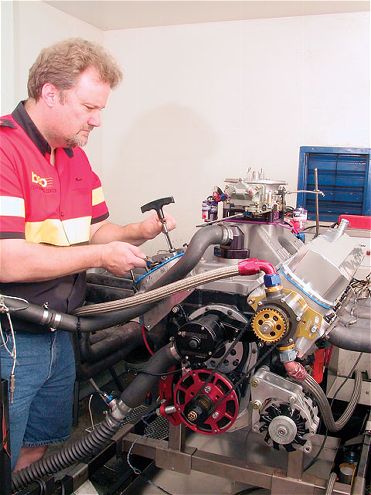 Some dyno shops are equipped to handle anything. R&R Performance has seen one-cylinder diesels and will soon tackle a 30-cylinder tank engine. This 600ci big-block sports a PSI screw charger and made 1,370 hp. It drinks 102 gallons of pump gas an hour. The customer ordered two of these engines for his boat.
Some dyno shops are equipped to handle anything. R&R Performance has seen one-cylinder diesels and will soon tackle a 30-cylinder tank engine. This 600ci big-block sports a PSI screw charger and made 1,370 hp. It drinks 102 gallons of pump gas an hour. The customer ordered two of these engines for his boat.
Fudging The Numbers
Dyno numbers released to customers often don't include the actual raw test readings for the engine. Customers are given corrected horsepower and torque numbers that are computed from the raw numbers to reflect changes in temperature, atmospheric pressure, and altitude. This correction factor provides a standard upon which testing can be equally compared under different weather conditions or from different locations. During this correction process, unsavory or ego-driven engine builders can fudge the numbers given to customers or magazines.
Tracy Dennis of Sunset RaceCraft Racing Engines dynos more than 400 engines a year. On some days, he runs eight engines as part of a sealed-engine race program for a foreign stock-car series. All of the 150 engines he has built for the series must leave the shop within a few ponies of each other. The engines are also dyno'd in the other country to confirm Sunset's consistency, so Dennis is very meticulous about calibrating his DTS dyno and keeping a close eye on all the correction-factor inputs to ensure repeatability.
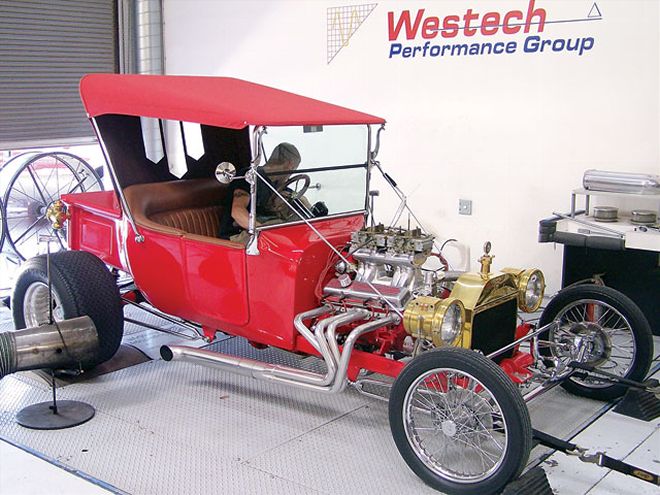 Some shops offer chassis dyno services to complement the engine testing or for final tuning.
Some shops offer chassis dyno services to complement the engine testing or for final tuning.
Dennis says the first opportunity for misrepresenting the numbers comes during the calibration. At a minimum, dynos should be calibrated once a week. This involves hanging a measured weight from a calibration arm that is bolted to the dyno's absorber. A 2-foot arm that weighs 7 pounds and is supporting a 150-pound ball at the end should factor in at 307 ft-lb. But if a 100-pound ball is hung from the arm (207 ft-lb), and the calibration baseline is still set at 307, the numbers generated by the dyno test will be higher because the absorber has a 100 ft-lb advantage.
Most dyno operators looking for an edge won't mess with the initial calibration but instead will fudge the other inputs to throw off the correction factor. In simple terms, dynos are usually programmed to correct the raw numbers to reflect how the engine would perform at sea level with 60-degree air temperature and a barometric pressure reading of 29.92 inches of mercury. If the dyno requires the operator to input the air temperature, altitude, or pressure, these numbers can be fudged to give higher horsepower correction. So if the air temperature across the carb is 78 degrees but the operator tells the dyno it's 95 degrees, a higher correction factor will boost the numbers.
Most dynos are linked directly to a weather station hung near the air inlet, but Dennis says the data acquisition software can be manipulated to juice the numbers. "The dyno operator can program the computer to correct to a barometric pressure higher than 29.92 inches and get more horsepower," he says.
Using a recent dyno test on a small-block, Dennis showed us a peak of 577 raw horsepower that corrected to 677. But by raising the atmospheric pressure point in the correction formula to just under 31 inches, the adjusted numbers showed more than 700 hp.
Nicky Fowler of Scoggin Dickey Parts Center often hears complaints about questionable dyno tests. He suggests customers request that the raw torque and horsepower numbers as well as the atmospheric conditions be included on the dyno printout. If the correction factor seems extraordinarily high, customers can ask the dyno operator for clarification. Customers who question the test day's weather conditions can check Weather Underground (www.wunderground.com) for a complete rundown of the weather history in any ZIP code. But make sure you understand all the weather definitions before you go charging back into the engine builder's shop. Dynos may measure absolute atmospheric pressure, not the pressure readings corrected to sea level you hear on the news. Vapor pressure and density altitude are other factors often used in dyno calculations. Both are computations from weather conditions not always found in weather reports. If you have accurate weather information, numerous Web sites offer dyno correction formulas that consider different weather factors. One of the easiest is wahiduddin.net/calc/ calc_cf.htm.
There are other tricks to fudge the numbers, even if the customer is in the control room watching. The classic move is allowing the air-inlet-temp sensor to rest on the intake manifold instead of reading the actual air temperature. The hotter temperature tells the computer to generate a higher correction factor.
Bottom line: Find reputable dyno operators who will work with you, be open with all the numbers, and answer all your questions.